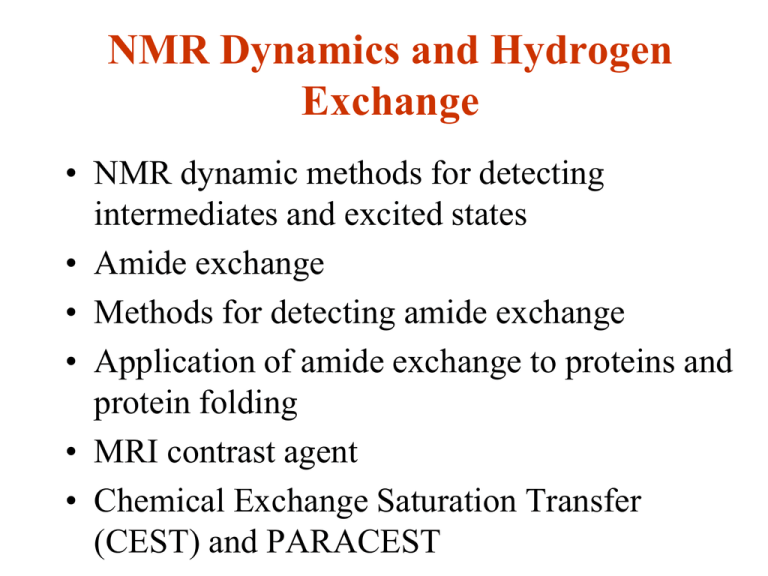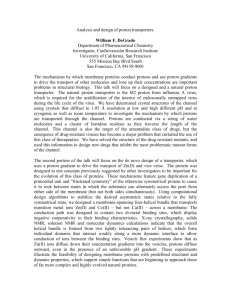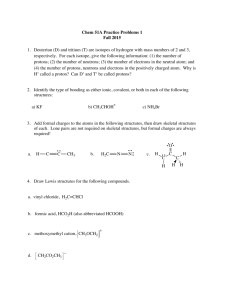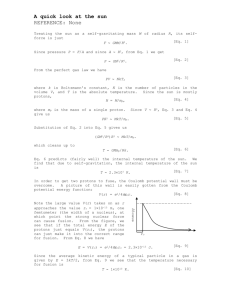NMR Dynamics and Hydrogen Exchange
advertisement

NMR Dynamics and Hydrogen Exchange • NMR dynamic methods for detecting intermediates and excited states • Amide exchange • Methods for detecting amide exchange • Application of amide exchange to proteins and protein folding • MRI contrast agent • Chemical Exchange Saturation Transfer (CEST) and PARACEST NMR Dynamic Experiments Initial NMR dynamics experiments in 1970s. Rapid advancements due to ability to label specific positions in bio-molecules and methodologies development Magnetization exchange spectroscopy (EXSY)-slow exchange 0.5 s-1 to over 50 s-1 CPMG relaxation dispersion: chemical shifts100~2000s-1, R1rho can extend to more rapid exchange (dot) Residual dipolar coupling (RDC) and PRE Sin relaxation for ns-ps CPMG and PRE are sensitive to low-lying excited states with populations > 0.5% H/D exchange can detect high energy excited states with much lower population A.Mittermaier, L. Kay (2009) Trends Biochem. Sci. 34, 601. A. Mittermaier, L. Kay (2006) Science. 312, 224 K. Wuthrich, G Wagner,(1978) Trends Biochem. Sci. 3, 227 Exchange Spectroscopy (EXSY) Mittermaier et al (2009) Trends Biochem. Sci. 34, 601. Slow conformational exchange in the protease ClpP ClpP, an oligomeric protease comprising 14 subunits with a total molecular mass of 300 kDa. (a) Surface representation of ClpP with two monomers shown as yellow and blue ribbons. Locations of dynamic isoleucine residues are identified by green and red circles. Substrate entry pores are indicated with blue arrows. (b) The 1H/13C methyl TROSY correlation spectrum collected for a uniformly [15N, 2H], Ile δ1 [13C,1H] labeled ClpP sample. I149 and I151 are each associated with two δ1 methyl peaks, designated F and S, reflecting slow exchange between two distinct, functionally important, conformations. (5 0C, rotational correlational time >0.4 us) R.Sprangers, PNAS, et al.2005 Wang JM, Cell, 1997 Carr–Purcell–Meiboom–Gill (CPMG) Relaxation Dispersion 100 s-1 ∼ 2000 s-1 Exchange between ground state and excited state is in the millisecond time scale kAB kex = kAB + kBA A B kBA kBA > kAB Shape of the dispersion depend on: • populations of the two states • chemical shift difference • the rate of exchange In a typical series of experiments, variable numbers of refocusing pulses are applied to magnetization as it evolves under the influence of a chemical shift that varies stochastically due to the exchange process Baldwin et al (2009) Nature Chem Biol 5, 808. Minisec Dynamics Relaxation Dispersion of DHFR Boehr et al (2006) Science 313, 1638. Relaxation Dispersion (Continue) Differences in chemical shifts between ground and excited states ( ) correlate with differences in peak positions between intermediates ( ), suggesting the excited states are similar to the conformation of the intermediates in the preceding or following step in the catalytic cycle. Boehr et al (2006) Science 313, 1638. Residual Dipolar Coupling (RDC) Mittermaier et al (2009) Trends Biochem. Sci. 34, 601. Spin Relaxation and Paramagnetic Relaxation Enhancement Mittermaier et al (2009) Trends Biochem. Sci. 34, 601. PRE Study of Maltose Binding Protein • PRE of holo form agree with Xray structure • PRE of apo form is larger than X-ray structure • The apo form is in a transient close form (5%) Grey: N-terminal domain Blue: C-terminal domain, apo Red: C-terminal domain, holo Mittermaier et al (2009) Trends Biochem. Sci. 34, 601. Hydrogen Exchange Method Hydrogen exchange (HX) techniques is described for measuring the approximate exchange rates of the more labile amide protons in a macromolecule. The exchangeable amides in proteins are: Exchangeable Nucleotides Hydrogen-Exchange Chemistry A minimum ~ pH 3.5 > 1hr at pH 3 < 1ms at pH 10 • Hx rate is catalyzed by OH- and H+ kintrinsic kex = koH [OH-] + kH[H+] + kw • All exchange rates are referenced to random coil polyAla at 0 C. • HX rates are sensitive to pH,local chemical environment, solvent, sidechain type, neighboring amino acids and temperature • kintrinsic for each amino acid is different pD = pH* + 0.4 Bai. And Englander. (1993) Proteins, 17, 75; Koide S.. and Wright PE J Biomol NMR. 1995 Nov;6(3):306-12. Simulated Exchange Rates for Labile Protons of Polypeptides • In H2O solution at 25 °C. • Im stands for imidazole ring NH, Gua for guanidinium NH, bb for backbone. • The amide protons have a large range of possible exchange rates under physiological pH (pH 6.5– 7.5). Wuthrich &Wagner JMB 1979 HX vs. Protein Structure In proteins, HX rates can be altered: H-bonding Shielding in the center of protein Shielding by binding another molecules pH and temperature Extremely slow exchange can be months,yrs Protection factor p = kintrinsic/kobs p > 106-107 for slow exchange Amide exchange rate contains information about secondary structural elements Hx Mechanism (Ex1/EX2) ko kintrinc Close p Open Exchanged kcl -Hvidt & Nielsen, 1966 • Solvent penetrates protein secondary structure • A protected amide hydrogen is ‘closed’ to exchange and becomes accessible to exchange through an ‘open’ state at the exchange rate for an unstructured peptide. Ex1: kintrinc >> kcl kobs = kop independent of pH Ex2: kintrinc << kcl kobs = kopkintrinc pH dependent Ex2 is typically encounted in proteins under conditions where folded state is stable and intrinsic exchange is relative slow HX is an excellent way to look at the stability of proteins • The rates of amide proton exchange for individual protons can be related to equilibrium constants for opening of individual hydrogen bonds. Knowing the equilibrium constants, one can calculate the free energy for the conformational transition which allows exchange to occur. • When certain protons are only exposed in the completely unfolded form then the equilibrium constants and Gs correspond to the global unfolding reaction. These protons are usually the slowest exchanging protons in the molecule. GHX = -RT ln(kobs / kintrinc ) • For mutation, the change of stability: GHX = ( GHX )wt- ( GHX )mut =-RT ln (kexwt /kexmut ) Folded-state Mechanism • "penetration"model – multiple, small, non-cooperative, internal fluctuations create ensembles of inter-converting conformations of varying protection,and provide transient access of solvent to buried NHs (Woodward et al., 1982). • "local unfolding" model – a helix undergoes cooperative breakage of H-bonds and exchangeable species have locally unfolded secondary structure (Englander &Kallenbach, 1984). • Miller & Dill model – exchange occurs from first-excited states that can have a slightly higher free energy, yet very different conformations than the native state, and could be produced by the types of protein motions invoked in both penetration and local unfolding mechanisms (Miller & Dill, 1995). Amide Exchange Rates •Adding D2O to our H2O solution and take spectra at different times, signals from different amide protons will decrease in size at different rates. We look at the NH to H fingerprint at different times in DQF-COSY or HSQC. 4.0 t = 0 - No D2O Add D2O 4.0 (H s) t = t1 4.0 t = t2 8.0 (NHs) 7.0 Amide Exchange Rates in ACP • Residues at the center of helices and hydrophobic core have slow exchange rates Kima Y, et al, BBRC, 2006 • The overall protection factors (< 10 4.5) are smaller than other proteins suggesting that ACP has high mobility • Helix II exchanges faster than helix I and helix III suggesting that Helix II is highly dynamic. Unfolding/Folding and Misfolding Competition Hydrogen Exchange 25x dilution 6M GuHCl H2O pH 7.5 Drop pH 3.8 D2 O Concentrating 1min Phosphate buffer pH7.5 NMR • The refolding experiment involved dilution of droplets of protein denatured in 6 M GuHCl in H2O solution into a denaturant free solution of D2O to initiate refolding and hydrogen exchange simultaneously. • After folding completed, HX is quenched by lowing the pH. • Comparing 2D NMR spectrum of the refolded protein with that was not denatured. Residues protected early in refolding can be detected using NMR. Competition HX of lysozyme • Using 65 slowly exchanging amide hydrogen as probes. The majority of residues in domain have exchange >30%. The majority of residues in domain have exchange <30% suggesting that two structural domains of lysozyme are folding domains that differ significantly in the extent to which protected structure accumulates early in the folding process. Miranker et al., Nature, 1991 Pulsed-Label Hydrogen Exchange •After an adjustable refolding time, tf, the protein is subjected to a short high pH pulse, where exchange of the unprotected NHs is very fast. NHs protected by structure within the folding time does not exchange during the short pulse •After a pulse time tp. The D to H exchange is quenched by rapidly lowering the pH. •After folding completed, the pattern of NH and ND labels in the refolded protein is analyzed by 2D NMR. •Increasing tf time, proton occupancies measured in the NMR spectrum decreases. Plotting proton occupancy vs. folding time tf. Identifying Folding Pathway by HX Pulse-Labeling (a) pure 2-state All probes achieve 100% protection at the same rate in a single kinetic step. (b) U -> I -> N sequential, I has A&B H-bonds with the same HX constant (c) U1 -> N(30%) U2 -> N(70%) two heterogeneous parallel paths (d) U1-> N U2->I->N contribution of intermediate and heterogeneous folding Parallel Folding Pathway of Lysozyme • All probes (50% of 126 amides) have one fast phase and one slow phase • Fast phase rates for both and domains are 10 ms • Slow phase rates for is 65 ms and is 350 ms, respectively. • domains folds before domain and different populations of molecules folded by kinetically distinct pathways Additional Methods for Amide-Water Exchange • • • • • • • • Hwang TL, Mori S. Shaka, AJ, and van Zijl PC, Application of Phase-Modulated CLEAN Chemical EX-change Spectroscopy (CLEANEX-PM) to detect water-protein proton exchange and intermolecular NOEs. JACS, 1997, 119,6203-6204. Hwang TL, van Zijl PC, Mori S. Accurate quantitation of water-amide proton exchange rates using the phase-modulated CLEAN chemical EXchange (CLEANEX-PM) approach with a FastHSQC (FHSQC) detection scheme.J Biomol NMR. 1998 Feb;11(2):221-6. Clean SEA-HSQC: a method to map solvent exposed amides in large non-deuterated proteins with gradient-enhanced HSQC J Biomol NMR 2002 Aug;23(4):317-22 Mori S, Abeygunawardana C, Johnson MO, van Zijl PC. Improved sensitivity of HSQC spectra of exchanging protons at short interscan delays using a new fast HSQC (FHSQC) detection scheme that avoids water saturation. J Magn Reson B 1995 Jul;108(1):94-8 Erratum in: J Magn Reson B 1996 Mar;110(3):321 Bougault C, Feng L, Glushka J, Kupce E, Prestegard JH. Quantitation of rapid proton-deuteron amide exchange using hadamard spectroscopy. J Biomol NMR. 2004 Apr;28(4):385-90. Miranker A., Robinson CVm Radford, SE, Aplin RT, Dobson CM. Detection of transient protein folding populations by mass spectrometry. Science. 1993 Nov 5;262(5135):896-900. Carulla N, Caddy GL, Hall DR, Zurdo J, Gairi M, Feliz M, Giralt E, Robinson CV, Dobson CM. Molecular recycling within amyloid fibrils.Nature. 2005 Jul 28;436(7050):554-8. Feng L, Orlando R, Prestegard JH. Mass spectrometry assisted assignment of NMR resonances in 15N labeled proteins.J Am Chem Soc. 2004 Nov 10;126(44):14377-9. Macnaughtan MA, Kane AM, Prestegard JH. Mass spectrometry assisted assignment of NMR resonances in reductively 13C-methylated proteins. J Am Chem Soc. 2005 Dec 21;127(50):17626-7. CLEANEX-PM spin-locking sequence: 135 (x) 120° (-x) 110° (x) 110°(-x) 120°(x) 135° (-x) CLEANX-PM has the ability to specifically monitor water-proton exchange without 1) exchange relayed NOE/ROE from rapidly exchanging protons (hydroxyl or amide groups) in the macromolecules, 2) intra-molecular NOE/ROE peaks from protein C H protons which has chemical shifts coincident with water, or TOCSY-type interactions. FHSQC CLEANEX-PM The FHSQC indicates proton signal that remain at the amide resonance through out the pulse sequence. The CLEANEX-PM indicates 1H signals that initiate in the 1H O resonance and then transfer to 1H amide resonance 2 during the mixing period of the pulse sequence. Staphylococcal nuclease –Hwang et al., 1998 Conventional [1H,15N]-HSQC spectrum of human ubiquitin. A 0.5 mM15N-labeled sample was prepared in 50 mMpotassium phosphate buffer in H2O/D2O 5/95, pH=6.2 600 MHz with cryoprobe. it required approximately 21 min using 128 t1 time increments and 4 scans per increment. Reconstructed Hadamard [1H,15N]HSQC Spectra for Ubiquitin (A) Data in 1H2O collected with 128 t1 increments in 20 min. The sample was then lyophilized overnight and brought back to its initial volume with 99.9% 2H2O and immediately returned to the spectrometer for rapid collection of a series of Hadamard spectra. (B) First point after 1 min in 2H2O collected with 4 scans in 42 s. Cross-peak intensities as a function of time Lines are best fits to I(t) =Io(exp(-kt)+const). The precision of the data is quite high with the estimated errors for rates in the range of 1 × 10-3 min1 being on the order of 5%. Rates derived also show reasonable agreement with previously published rates. Amide H/D Exchange in Mass Spectrometry Advantages: • fast, no back exchange • low concentration of protein D0 = deuterium uptake of the apo-protein DI = difference between the deuterium level of the complex and that of the apo form I= overall binding constant Zhu et al. (2004) J Am Soc Mass Spectrom 15, 388. Intermediates Determined by H/D Exchange Englander (2005) PNAS 102, 4741. What is CEST? • CEST is an acronym for Chemical Exchange Saturation Transfer. In early experiments, it was also referred to as Saturation Transfer or Magnetization Transfer (MT). • CEST involves chemical exchange of a nucleus in the NMR experiment from one site to a chemically different site. • When a nucleus having a net magnetic spin (the proton spin quantum number, I, equals ½) is placed in a magnetic field, the spins orient either in the same direction as the magnetic field (low energy- ) or against the field (high energy- ). The distribution of spins between these two energy states is determined by the Boltzmann equation. Zhang S.,… Sherry AD, 2003 Contrast Agents vs. relaxation i ii Kex Gd Kex Rf Rs Gd Kex Rf Gd Rf 1 T1 cq T1M 1 M c 1 T1e 1 1 m R Current CAs A major barrier to the application of MRI technique is its low sensitivity and contrast limited by the fast rotational correlation time of the molecule (ps). Macromolecule generated by either covalent binding or the non-covalent nature of the binding between the monomeric agent and the macromolecules has the improvement in proton relaxivity is much less than the expected increase based on the molecular-weight increase due to high internal mobility of the paramagnetic moiety and limited water exchange rate. ProCAs developed by protein design with increased relaxivity by controlling relaxation and the capability of targeting specific molecular entities such as cancer biomarkers. Yang, JJ, JACS, 2010 , Wei et al., 2009, Qiao et al., 2011 Relaxivity theory 1 T1 cq T1M 1 M c 1 T1e Yang, JJ, et al. JACS, 2010 , Wei et al., 2009, Qiao et al., 2011 1 1 m R Protein-based Contrast Agents (ProCAs) CEST principle ≥ kex Two-site chemical exchange model. The small pool (s) reflects dilute exchangeable solute protons. The large pool (w) reflects bulk water protons. R1, R2, and M0 are the spin–lattice relaxation rate, spin– spin relaxation rate, and equilibrium magnetization, respectively. ksw and kws are the exchange rates of protons from pool s to pool w, and vice versa Bloch Description for Two-site Exchange This CEST process is in competition with • relaxation. In addition to suitable exchange kinetics, a CEST effect will only be observed if the relaxation times of the two pools are long relative to the exchange rates. Zhou J & van Zijl PCM, 2006 Zhang S.,… Sherry AD, 2003 z-spectroscopy or CEST-spectroscopy The resulting MTRasym curve for offsets 0–5 ppm from water has an offsetdependent shape that depends on the inherent MTRasym of the solid-phase MT effect as well as on the PTR of the contributing exchangeable protons Diamagnetic compound can alter the bulk water signal and thereby act as contrast media for MRI Zhou J & van Zijl PCM, 2006 NMR vs. CEST • For NMR spectroscopy, severe line broadening leads to a drastic lowering of signal-to-noise ratio (SNR). The NMR detectability reduces when going from low temperature (4 °C) to physiological temperature. • The CEST effect may still have similar or even higher sensitivity because at least partial saturation still occurs for most of the solute protons due to a finite irradiation bandwidth. The CEST detectability approximately doubles. First Demonstration of CEST Imaging by Wolff and Balaban • The inner part contains pure water, and the outer contains a dilute ammonium chloride solution (25 mM, pH 5.4). • RF irradiation was applied at −2.5 (a) and +2.5 ppm (b) from the water resonance, showing the transfer effect of the saturated ammonium protons. Wolff and Balaban, JMR 1990 Brain Water exchange (WEX) spectroscopy • • • • • • • The amide proton exchange rates and the amide proton signal intensities in situ in the rat brain just before and just after cardiac arrest. The amide proton content remains constant in this early postmortem period, while the amide proton exchange rate changes from 28.6±7.4 s in vivo to 10.1±2.6 s postmortem. Because of the lack of change in amide intensity, it was concluded that this rate change is due to the pH reduction upon death. To calibrate the exchange rate changes in terms of intracellular pH (pHi) changes, phosphorus spectroscopy was also performed, giving pHi values of 7.11±0.13 and 6.66±0.10 for in vivo and postmortem, respectively. Amide proton exchange is predominantly basecatalyzed for pH>5, the following equations were deduced Ksw = kb [OH] =kb x 10pH-pKw =5.57 x=5.57x10pH-6.4 in which pKw=15.4 at 37 °C. Zhou J & van Zijl PCM, 2006 APT effects during focal ischemia in the rat brain (a,b) Comparison of ipsilateral magnetization transfer effects in the caudate nucleus at 2 h of ischemia (n = 2) with 5 h post-ictus (4 h ischemia and 1 h postmortem; ), showing noticeable increase in water content (narrower magnetization transfer curve (a) without changes in MTR asym at 3.5 p.p.m. offset (b). (c,d) Ipsilateral ( ) and contralateral MTR asym and PTR data for the caudate during ischemia (n = 7). MTR asym spectra (c) compare very well with those for normocapnic and postmortem brain, and the magnitude of PTR at the offset of 3.5 p.p.m. (d) is similar for the normocapnia/postmortem case. (e−i) Comparison of T 2-weighted (e), isotropic diffusion−weighted (f), 2,3,5-triphenyltetrazolium chloride (TTC)stained (g), absolute MTR asym (3.5 p.p.m; h) and absolute pH images (i) for ischemic rat brain. The MTR asym (3.5 p.p.m.) images, which are pH-weighed were acquired using frequency-labeling offsets of 3.5 p.p.m. (40 scans). Macromolecular Contrast Agents H z-spectra for cationic polymers obtained at 500 MHz, T=37 °C, and pH 7.3–7.4. CEST effects of different magnitude were measured for solutions of approximately equal amide proton concentration (xCA=0.0021–0.0029) for PLL (100 μM, NCA=4.78 protons/kDa, MCA=488 kDa), PLE (500 μM, NCA=6.62 protons/kDa, MCA=70 kDa), and SPD-5 (1000 μM, NCA=8.74 protons/kDa, MCA=28.825 kDa). Potential agents with amine protons were also tested: PAA (xCA=0.0041, 300 μM, NCA=21.61 protons/kDa, MCA=70 kDa) and PEI (xCA=0.0095, 150 μM, NCA=9.29 protons/kDa, MCA=750 kDa). The curves for PAA and PEI coincided and only the one for PEI was displayed. No noticeable effect was found for PAA and PEI. • A polymer can possess multiple functional groups. When these contain exchangeable protons with the same chemical shifts they function as a CEST agent with high exchangeable site concentration. Exploiting the inherent properties of polymer amide protons that rapidly exchange with water, Goffeney et al. showed that enhancements in sensitivity by factors as large as 500,000 are possible for amide protons on cationic polymers. • From the viewpoint of in vivo CEST measurements, amide hydrogen exchange has a favorable exchange rate range ( 10–1000 s) under physiological conditions. On the other hand, amine protons have a very high exchange rate. Therefore, several amide and amine containing compounds were evaluated, including PLL, poly-l-glutamate (PLE), generation-5 starburst PAMAM dendrimers (SPD-5), polyallylamine (PAA), and polyethylenimine (PEI) Goffeney.. Van Zijl, JACS, 2001 Frequency-selective radiofrequency pulses label (green) the amide protons These protons exchange with water protons, reducing MRI signal intensity ( SI). (b) LRP cloning. (c,d) Immunofluorescent polyclonal-antibody staining against LRP (red) and nuclear staining (blue) in rat 9L-glioma cells (scale bars, 100 m). Only cells expressing LRP (c) show intense cytoplasmic antibody binding; control cells (d) show mainly nonspecific perinuclear staining. (e) MTS assay for mitochondrial metabolic rates (mean s.d.) shows no inhibitory effect of LRP on cell metabolism/proliferation. Zhou ..van Zijl, Nat. Med., 2003 CEST imaging of poly-L-lysine (30 kDa) samples and LRP and control cell extracts (a) Phantom layout. (b) Reference image at = –3.76 p.p.m. (scale bar, 1 mm). (c) Signal intensity– difference map showing samples labeled at = 3.76 p.p.m. normalized by signal intensity at – 3.76 p.p.m., superimposed on reference image (pixels outside capillaries excluded) (scale bar, 1 mm). (d) t-test map comparing = 3.76 p.p.m. (pixels with P < 0.05 shown in color) (scale bar, 1 mm). (e) Signal intensity–difference quantification (mean s.d.; n independent experiments) for LRP pooled clones, control cells and four LRP clones. Significant effects (t-test, two-tailed, unpaired, P < 0.05): *for signal intensity ( 3.76 p.p.m.); **between LRP and control. (f) RT-PCR of corresponding cells in e. Clones have the typical lrp 'ladder' pattern, contrary to control. Zhou ..van Zijl, Nat. Med., 2003 In vivo imaging of LRP (a) Anatomical image. (b) CEST signal intensity–difference map overlaid on a distinguishes LRP-expressing and control xenografts; (c) signal-intensity differences (mean s.d.; six mice, each containing two xenografts; *, P = 0.03, two-tailed, unpaired t-test); to compare different mice signal-intensity changes were normalized to make signal-intensity change of normal brain zero. Proper adjustment of field homogeneity could only be done inside the brain, leading to some artifacts at brain edges. (d) RT-PCR of xenografts from rat brains. (e) Anatomical image. (f) Eosin-hematoxylin stain of frozen section corresponding to LRP tumor in e. (g) Magnification of f shows a uniform tumor mass. Scale bars: 2 mm for a, b and e, 500 M for f and 100 m for g. Zhou ..van Zijl, Nat. Med., 2003 Several experimental issues are important for CEST imaging • • • • • Most important is proper centering of the water resonance in each pixel to accurately determine the = 3.76 p.p.m. signal-intensity difference, which depends on sufficient magnetic field homogeneity. CEST contrast improves at higher fields. Fortunately, the CEST effect from LRP is more frequency selective than that of the total amide proton pool in the target cells and therefore distinguishable. CEST contrast directly depends on both the total concentration of amide protons and their exchange rate. For 22 kDa poly-L-lysine, an amide proton exchange rate of 403 s-1 was measured at pH = 7.3, in contrast to a rate of 28 s-1 for combined amide protons of multiple endogenous proteins in situ in rat brain12. The availability of MRI methods for measuring amide proton exchange rates through the water signal15 will allow determination of the presence of the contrast agent. Another feature of LRP is that amide proton exchange is base catalyzed and thus strongly pH dependent (the rate is reduced by a factor of 10 per pH unit). Thus, contrast is lowered by an order of magnitude during ischemia or cell death, whereas (super)paramagnetic agents may persist in dead cells for weeks to months. PARACEST effects • z-Spectra of Eu–DOTA–4AmCE (a) and Nd–DOTA–4AmCE (b) obtained at 4.7 T (63 mM, pH 7, room temperature, saturation power 16.4 dB, saturation time 1 s). The CEST peaks of the complexes appear near +50 ppm for Eu–DOTA–4AmCE and −32 ppm for Nd–DOTA–4AmCE. The bulk water signal is reduced by 57 and 48%, respectively. The bound water resonances are clearly visible in the 500 MHz H NMR spectra, indicating fulfillment of the slow exchange regime.







